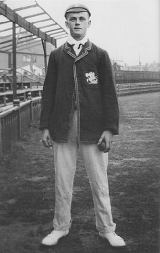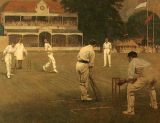Blythe's canvas immortality
Gideon Haigh looks at Kent's slow left-arm hero Charlie Blythe
Gideon Haigh
01-Aug-2006
Odd Men In - a title shamelessly borrowed from AA Thomson's fantastic book - concerns cricketers who have caught my attention over the years in different ways - personally, historically, technically, stylistically - and about whom I have never previously found a pretext to write
|
|

|
Wednesday week marks a hundred years since a game of forgotten feats but immemorial imagery. Over three days from 9 August 1906, Kent overcame Lancashire at Canterbury's St Lawrence Ground by an innings and 195 runs, thanks largely to 176 from their elegant amateur Kenneth Hutchings and destructive fast bowling from Arthur Fielder, en route to securing their first county championship of the modern era. But it would have receded into antiquity like myriad others of the period had not it become the subject of an extraordinarily detailed likeness by the salon painter Albert Chevallier Tayler.
E. W. Swanton reckoned it "one of the finest ever portrayals of distinguished identifiable cricketers in action"; it is by some way the most valuable, having fetched £600,000 at auction last year. The eye falls first, out of habit, on the striking batsman: the diminutive figure of Lancashire's Johnny Tyldesley, who had taken the Kent bowlers for 295 earlier in the season, but whose dismissal for 19 and 4 here was a leading indicator of Lancashire's eclipse. But the image is set in motion by the figure of Kent's slow left-arm hero Charlie Blythe, about to release from the pavilion end where he was favoured by a slight slope, in the setting where his 281 wickets cost less than 15 runs each.
The opposition is an intriguing one. Although Hutchings and Fielder were the match's undoubted stars, ahead of greater feats the following year in Melbourne where the former made a hundred in a session and the latter conjured the winning runs in a one-wicket victory, Lord Harris apparently insisted that Blythe be the bowler in the picture. By homing in on Blythe's duel with Tyldesley, Tayler makes the game's defining contest, in a period defined even in the writings of C. L. R. James as a belle époque of amateurism, that between two skilled professionals. What's more, they strike attitudes of exquisite poise. Tyldesley's trim figure, still but relaxed, is nearly upright, the high-gripped bat placed daintily in the block, the toe of his front foot poking toward cover. And Blythe, hovering above the crease, face fixed, body tensed, front foot arched in space, invisible arm about to begin its upswing - Blythe's arm, in fact, came, with a studied nonchalance, from behind his back, hiding the ball until it left the hand. Harry Altham's description of Blythe in action might well serve as its caption:
The very look on his face, the long, sensitive fingers, the elastic back sweep of the arm before delivery with the right hand thrown up in perfect balance against it, the short dancing approach approach, the long last stride, and the final flick of the arm as it came over, all these spoke of a highly sensitive and nervous instrument, beautifully coordinated, directed by a subtle mind, and inspired by a natural love for its art.
Blythe came from unpromising material, the son of an engine-fitter at the Arsenal. "Blythe lived at Deptford," wrote his Kent mentor Captain William McCanlis, "a place one would hardly go in search of cricketers. The lads of this town have only the roughest parts of Blackheath on which to play their occasional cricket." McCanlis first spied Blythe as "one of the crowd" bowling idly at Walter Wright when Kent visited the town; impressed by what he saw, McCanlis invited the boy to trial at his Tonbridge "nursery". Observing his slim build and high forehead, Cardus the junior romantic's nurtured an elaborate fantasy of Blythe's aristocratic past until it was rudely disturbed by hearing him twit a teammate: "I'll `it yer on top o' the nose in a minute!" Yet he began his portrait of Blythe in Good Days (1934) with an aesthete's appreciation: "Blythe of Kent - what a name, how perfect for the prettiest slow left-handed bowler of his, or surely any other, period!" And he was right to sense delicate sensibilities behind the deceptive flight. Blythe played the violin with his supple spinner's fingers; likewise on big occasions, the tendency exacerbated by epilepsy, was he strung up to concert pitch.
A year after Blythe's canvas immortality, he achieved a cricket indelibility, taking 17 Northants wickets in a day at Northampton, then in the Test at Headingley the following month 15 South African wickets for 99. C. B. Fry called the latter game "the tautest cricket match in which I have ever played", and perceived the toll on its star: "The strain of the match was severe, especially on Colin Blythe, who was completely knocked up. From start to finish he never bowled a single ball except of impeccable length. The situation was that three bad overs could have lost the match." The strain was such, in fact, that in the next ten days, a wan Blythe could winkle out only four county batsmen for 313. He bowled well at The Oval, then on the Ashes tour that winter failed altogether: Philip Trevor could hardly believe it was "the real Blythe", as "he often found it difficult even to keep a good length".
|
|

|
It was situations rather than opponents that troubled Blythe, for he removed batsmen in county cricket with almost surgical deftness - throughbred batsmen, too, including Gilbert Jessop nineteen times, Tom Hayward and his protégé Jack Hobbs seventeen times each. Yet now a reputation for frailty would precede him, preventing improvement on his 100 Test wickets at 18.63 and more than three Players caps against the Gentlemen, as well as the availability of the perhaps less artful but certainly more arch Wilf Rhodes. Unlike Rhodes, for example, Blythe was singularly uninterested in batting, and conveyed that indifference to spectators - so much so that correspondence broke out in the columns of The Cricketer in 1978 about whether he was right or left-handed, answered finally on the authority of his teammate Frank Woolley: "He was a right-hand batsman who spent very little time at the crease, say at the most four balls."
In his last season, Blythe was as potent as ever, striking with undisturbed regularity for 170 wickets at 15: he was thirty-five, and might have bowled on for a decade and more. But young men with his socio-economic background went mainly in one direction after September 1914. Enlisting in the Kent Fortress Engineers soon after the outbreak of war and attached to the Yorkshire Light Infantry, he lost his life to a random shellfall on the railway between Pimmern and Forest Hall two days after the capture of Passchendaele village, the news coming soon after another shell claimed the life of Hutchings. He was to be twice remembered at his happiest hunting ground: as a soldier by two shrapnel-streaked wallets on display in the pavilion, and as an artist in Tayler's painting by his heel hovering an inch or two above the ground, forever.
Gideon Haigh is a cricket historian and writer